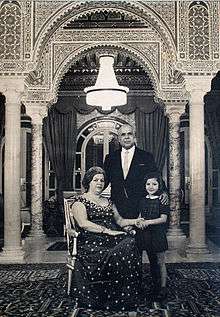Wassila Ben Ammar
| Wassila Bourguiba | |
|---|---|
|
Wassila Bourguiba in 1962 | |
| First Lady of Tunisia | |
|
In office 12 April 1962 – 11 August 1986 | |
| President | Habib Bourguiba |
| Preceded by | Moufida Bourguiba |
| Succeeded by | Naïma Ben Ali |
| Personal details | |
| Born | 1912 |
| Died | June 22, 1999 |
Wassila Ben Ammar (Tunisian Arabic: وسيلة بن عمار), was born in 1912 in Béja and died on June 22, 1999 in La Marsa, Tunis. Wassila was the second spouse of the former Tunisian president Habib Bourguiba and the First Lady of Tunisia from 1962 until 1986. She was called Majda (venerable).[1]
Biography
Family, youth and marriage
Ben Ammar's father, lawyer Mhamed Ben Ammar, belonged to a relatively impoverished Tunisian bourgeois family previously composed of senior officials and large landowners. Her mother, Fatma Dellagi, also came from the Tunisian bourgeoisie.[2]
Wassila met Bourguiba for the first time on 12 April 1943, when she came to congratulate him on his release after five years of detention. "It was love at first sight", wrote Habib Bourguiba in his autobiography Ma vie, mon oeuvre (French: "My Life, My Work"). Wassila at that time already had a daughter by a small landowner.
Through her budding relationship with Bourguiba, she had a considerable influence over the abolition of the monarchy of the Bey of Tunis and promoted the proclamation of a republic on 25 July 1957. After this, she strongly supported Ahmed Ben Salah, who was appointed on 29 July 1957 as Secretary of State for Public Health and Social Affairs, a minister-equivalent role.
Habib Bourguiba married Wassila on 12 April 1962, about a year after her divorce from Moufida Bourguiba on 21 July 1961. The son of Habib Bourguiba and Moufida, Habib Bourguiba, Jr., has demonstrated a certain animosity toward his stepmother. Since she was from a family of the traditional Tunisian bourgeoisie, which included influential and rich men, some of Tunis ministers saw in this marriage a way to detach Bourguiba from the ministers of the Tunisian Sahel from which Ben Salah originated. Indeed, her support for the latter did not last when he started gaining power.[3]
A powerful and influential first lady

Wassila gradually became very influential in the presidential palace affairs of Carthage (she was called the "Lady President") even though Bourguiba seemingly kept her away from political affairs. According to former minister Tahar Belkhodja, she was the "gateway to all the presidential ministers and their staff."
She showed momentary solidarity with the Prime Minister Hedi Nouira in her opposition to the proposed union between Tunisia and Libya in 1974, although overall they were hostile to each other according to Sadri Khiari.
In 1980, at the time of the attack against the city of Gafsa by an Arab nationalist commando, she acted to appoint Driss Guiga as Interior Minister and Mohammed Mzali as Prime Minister, while Mohamed Sayah was rather more in favour. She also named some of her friends in government positions. For the parliamentary elections on 1 November 1981, the first multi=party elections since independence, she supported the falsification of results to undermine the opposition victory, represented particularly by the Movement of Socialist Democrats Ahmed Mestiri. She was also the main architect of the installation of the Palestine Liberation Organization and its leader Yasser Arafat in Tunis headquarters, after their evacuation from Beirut in 1982.[4] Bourguiba, aging and ailing, gave her more and more responsibilities in state affairs. Wassila was "permanently connected to telephone conversations.[5]"
She ushered in a review of the 1959 Constitution which provided for the Prime Minister to become the legal successor to President. She contradicted her own husband in an interview for Jeune Afrique published on 28 February 1982. In 1983, Mzali sacked Tahar Belkhodja, then the information minister and friend of Wassila. A few months later the "bread riots", which took place from 27 December 1983 to 6 January 1984 took place; Minister Guiga, to whose appointment she had contributed, dismissed.
Habib Bourguiba sharply announced a divorce with a simple press release on 11 August 1986, while his wife was away in the United States for several months.
End of life
Later, Wassila moved to Paris. Following her former husband's dismissal on 7 November 1987, the Tunisian press announced that she had sent the new president Zine El Abidine Ben Ali a message "expressing her confidence in the new political leadership" and "satisfaction with the rendered respects to the former president". After two and a half years of absence, she returned to Tunisia in July 1988. She died on 22 June 1999 and, unlike the first president's wife, she was not buried in Bourguida mausoleum in Monastir.[6]
She is the aunt of Tarak Ben Ammar and the great-mother of Yasmine Tordjman-Besson, who became the wife of the French Minister Eric Besson.
References
| Wikimedia Commons has media related to Wassila Bourguiba. |
- ↑ Tahar, Belkhodja. Les trois décennies Bourguiba. Témoignageéditeur=Publisud (in French). Paris: 1998. p. 14. ISBN 978-2-866-00787-4.
- ↑ (French) Samy Ghorbal, « Que reste-t-il des grandes familles ? », Jeune Afrique, 18 juin 2007
- ↑ Mohsen Toumi, La Tunisie de Bourguiba à Ben Ali, coll. « Politique d'aujourd’hui », éd. Presses universitaires de France, Paris, 1989, p. 125 ISBN 978-2-130-42804-6
- ↑ (French) «Wassila Ben Ammar», Le Monde, 25 juin 1999
- ↑ Tahar Belkhodja, op. cit., p. 174
- ↑ (French) Philippe Bernard, « Le Libérateur », Arabies, mars 2006
